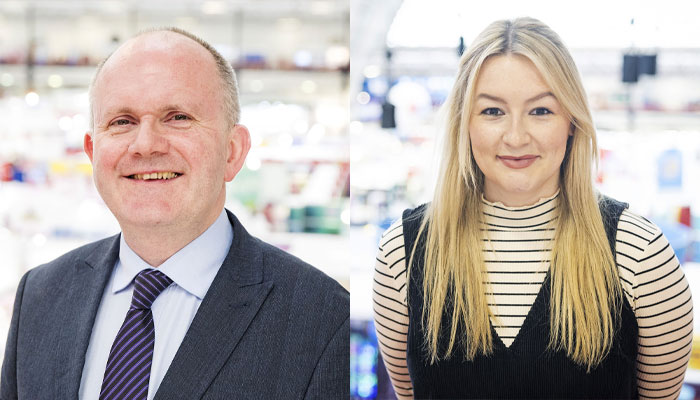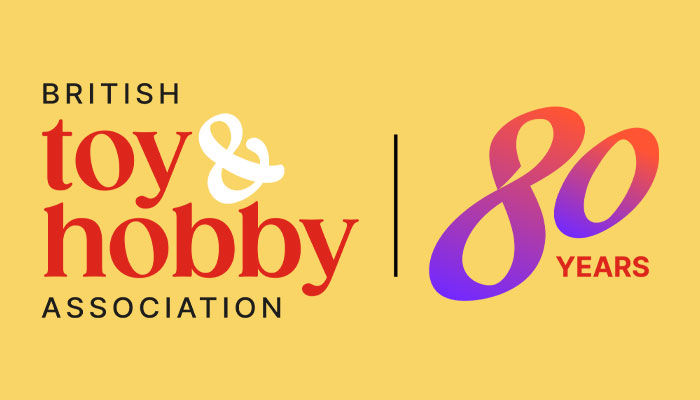BTHA’s Roland Earl and Rebecca Deeming-Mitchell on inventor engagement, industry evolutions and London Toy Fair 2025

Guys, it’s always great to chat. For anyone reading that might be new to the British Toy & Hobby Association, how would you sum up what you do?
Rebecca Deeming-Mitchell, Senior Communications & Event Manager, BTHA: Well, this year the Association is celebrating its 80th anniversary. When it was set up in 1944, its purpose was to protect and promote the best interest of its members – and our members are a broad range of primarily toy manufacturers.
Roland Earl, Director General, BTHA: And regarding the R&D and inventor community, we’ve always valued product design. It’s a very important part of the toy business. Obviously that’s alongside issues of pricing, placement, promotion, distribution, laws and regulations… And all of that affects toy designers and inventors in some way too. Although, unlike Mojo Nation, we’re not focused on that area – we don’t give out design advice per se – we think it’s an incredibly important aspect of the industry.
And we are a point of call for our members on things that they must consider when designing toys. Not in terms of how brilliantly innovative they’ll be, or how they’ll sell, but more with regards to safety regulations, environmental regulations, marketing, trade rules and general areas around how toys are made.
You mention the 80th anniversary – what sparked a need for a toy association here in the UK?
Roland: Well, the Association was founded in an odd time – July 1944. World War Two was still happening, but it looked like the war would end at some point. During the war, the countries involved stopped making toys and turned their factories over to making things for the war effort. Toy makers in Britian got together and said: “The War is going to end soon and one of the key issues we have is the rationing of materials. We need metal, wood, paper, board and rubber.” Their aim was to get these materials after the War, and that was one of the key reasons for the Association be founded.
There was also a preoccupation with government tariffs in the late Forties and early Fifties. There were lots of import and export controls, and issues around exchange rates. These sound boring but were very important at that time. Essentially, the Association wanted to represent the reputable toy industry; people who do things properly.

What are some of the biggest evolutions the Association has gone through in its 80 years?
Roland: The make-up of our members has shifted. When the Association launched, there were thousands of people retailing toys in all sorts of different places. Oddly enough, there weren’t that many people actually making toys. Gibsons was a founding member of the BTHA and they are still a member now, but there were also companies that were huge then but unheard of now… Like Lines Bros based in Tooting. They accounted for a large amount of toy sales in the UK. Over the years, the nature of retailing has changed, but we still hugely value the independent retail scene. Manufacturing has of course changed too – as has the nature of play, and the scope of entertainment available to children. And thankfully, toys still play a very important part in that. They haven’t lost their shine, but they do have more competition.
Rebecca: I’ve been here for nine years now, and I’d point to the Make Time 2 Play campaign as another exciting thing the Association embraced in its more recent history. The campaign aims to promote the importance of play and the vast benefits of play. We have a free app filled with play ideas…
We’ve also done a lot more training seminars for our members in recent years. Those provide great insights to members on a raft of different areas, from responsible marketing to environmental issues.

Roland: Another way in which the Association has changed over the years is that we’ve become more international. When it first started it was very much British companies, but we’ve since invited and allowed international companies who do good business in Britain to be a part of our community. That includes the likes of TOMY, Bandai, Hasbro, LEGO and Mattel. That has been an excellent thing.
With all that being said, the core objectives of the Association remain much the same: to protect and promote the interests of our members – and ensure the only members we have are reputable companies. We do turn people down!
Great stuff. I also wanted to ask you about what the BTHA does that ensures people don’t leave – because so many of you have been with the Association for an impressive stretch of time!
Rebecca: On this, I’d like to say something about Roland – because he’d never say this about himself! Roland is a very good Director and he goes above and beyond with all of us at the BTHA – even if we had a personal problem. He’s so encouraging with your own professional development as well. The same goes for lots of my colleagues. It’s a lovely place to work and everyone gets on.
I’ve been here for almost nine years – and I didn’t expect to be here for so long! With us being quite a small company, people’s roles evolve over time; you get the opportunity to work across different areas. That keeps things interesting – and toys is a fun industry! Our members are full of lovely people too, which helps! I’ve never woken up dreading to go to work.
Roland: Thanks Becky. What a lovely thing to say. And Becky’s right, it’s a marvellous team. We have a great relationship at work. While we haven’t had much change personnel-wise, we do try to help people swap roles if they want to do that. In a small team, boredom can set in, so we have to be nimble and sensitive to that. And as Becky says, the people we deal with outside of the BTHA are great. It’s a fun industry – and it ought to be! It’s a creative industry and the Mojo audience is the engine room of it really.
Our members are very loyal too – it feels like a real community. Look at our board meetings… Most of these companies are fierce rivals, yet most people leave their company hats at the door and are happy to think of things to benefit the wider industry. That’s a very nice thing and something that’s easy to take for granted.
The BTHA’s Director General from 1944 to 1979 was the same guy. My predecessor was the Director General from 1979 to 2008. So we’ve only had three – including me – Director Generals since the war…
Rebecca: It doesn’t sound like we’re getting rid of Roland any time soon!
Roland: It’s about time for a fourth Director General isn’t it! But yes, while we have continuity at the BTHA, the wider toy industry has quite a continuity too. People find it hard to leave the toy industry – it’s nice!
Before we start to wrap up, I wanted to talk about The Toy Trust – the UK toy industry charity. For anyone new to it, how can inventors get involved with supporting The Toy Trust?
Rebecca: Every year we do a big summer fundraising event. This year’s is called Midsummer Mayhem – and there’s still time to get involved. You can do whatever you want to raise money. We have a list of suggested activities on The Toy Trust website... Could be a quiz, a bake sale, a physical challenge… All the details on getting involved in that can be found here.

Roland: The Toy Trust was founded so that the Association – on behalf of its members, retailers and the wider industry – can raise money for children’s charities. We have a group of people who diligently look at the charity applications to ensure they meet our criteria and then a grant is approved. Generally, we’ve supported the smaller charities – whether local to the UK or to Africa, it doesn’t really matter.
And these donations truly make a difference. I remember a wooden bridge had washed away in Fiji during a tidal disaster. The kids needed to cross that bridge to get to school, so some children were now swimming across a horrendous river to get there. They didn’t need much money to rebuild it, and The Toy Trust helped rebuild it. And all of this doesn’t preclude companies doing their own fundraising for their own charities – which many toy companies do. We’re a very considerate industry in that regard.
And as well as going to that link, people can also drop Matt Jones a line at [email protected] if they want more information on The Toy Trust.
Fantastic. Guys, my last question for you centres on London Toy Fair. Why should designers and inventors be attending the show in January?
Rebecca: With over 250 exhibiting companies, and visitors ranging from buyers to inventors, Toy Fair is a fantastic networking opportunity. We did our first Inventors Lunch at this year’s show and hope to do that again at Toy Fair 2025. That’s a great opportunity on the third day of the show for inventors to get more quality time with exhibitors and each other.

Roland: It’s a people business and great things can happen if you’re at the right place at the right time. You might spot something that gives you an idea for a concept or an innovation… I know we’re all terribly young but there used to be more days to the show. Exhibitors and participants wanted a shorter, busy show and that’s what we have now. And with fewer days, you must be organised to ensure you get the most out of it. So, we encourage inventors to come to Toy Fair and want to facilitate these types of meetings and conversations as best we can. We want Toy Fair to be the most comfortable and professional environment to do business in our sector – whatever ‘doing business’ means to you.
And we can always improve! If inventors have any ideas about how we can improve the Toy Fair experience for inventors, please contact me. My email is [email protected] and we’d welcome thoughts.
Great answer. Guys, this has been great. A huge thanks again.
























